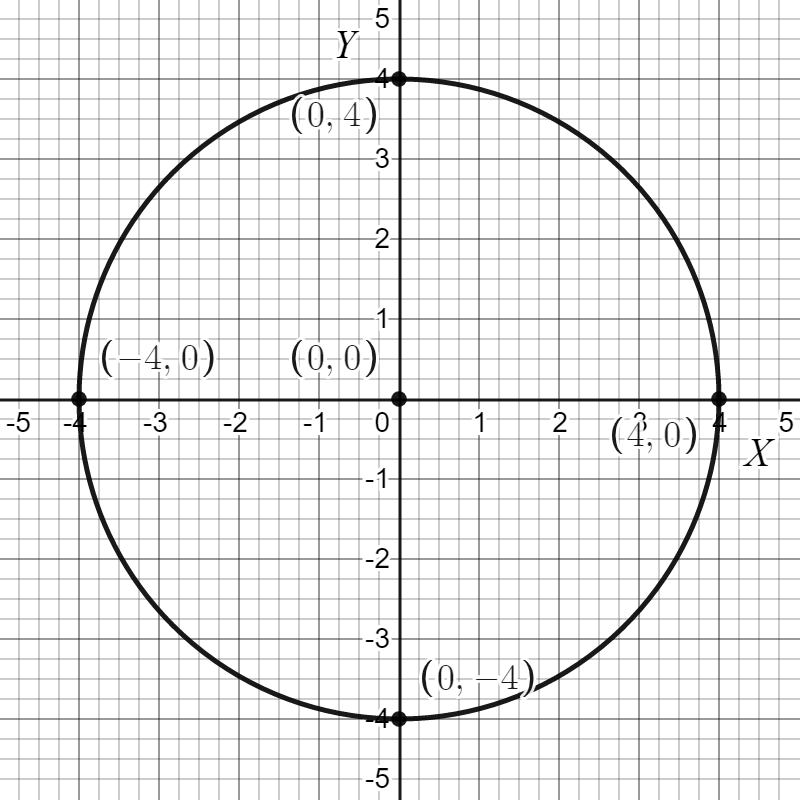
GRE Prep Club Daily Prep
Thank you for using the timer - this advanced tool can estimate your performance and suggest more practice questions. We have subscribed you to Daily Prep Questions via email.
Customized
for You
Track
Your Progress
Practice
Pays
Not interested in getting valuable practice questions and articles delivered to your email? No problem, unsubscribe here.
A circle is represented by the given expression
[#permalink]
 02 Dec 2021, 03:42
02 Dec 2021, 03:42
2
Expert Reply
4
Bookmarks
Question Stats:
 33% (00:30) correct
33% (00:30) correct
 66% (02:38) wrong
66% (02:38) wrong  based on 6 sessions
based on 6 sessions
Hide Show timer Statistics
A circle is represented by the given expression: \(x^2 + y^2 = 16\). How many integer coordinates are enclosed by or on the circle?
Show: ::
49
Re: A circle is represented by the given expression
[#permalink]
 04 Dec 2021, 01:22
04 Dec 2021, 01:22
1
Expert Reply
We know that the generic equation of a circle is:
\((x - h)^{2} + (y - k)^{2} = r^{2}\)
where $(h, k)$ is the center of the circle and r is the radius of the circle.
We are given the equation:
\(x^{2} + y^{2} = 16\)
\((x - 0)^{2} + (y - 0)^{2} = 4^{2}\)
By taking a look at it, we can see that the value of (h, k) is (0, 0) here. Which means that the center of the circle is on the origin (0, 0). Also, the radius of this circle is 4.
The figure of this circle is given as follows:

We can either check the figure to find out the total number of integer coordinates inside the circle or exactly on the circle. Or we can also check this by putting different values of x and y and find out the answer as well.
If we put different positive and negative integer values of x and y, then the answer of left hand side of the equation has to be less than or exactly equal to 16. Any coordinate that produces a result greater than 16 is not our answer as it will be outside the circle.
\(x^{2} + y^{2} = 16\)
- We can see that if we put $x = 0$, then we can put y = 1, 2, 3, 4 in the above equation and our result will be less than or equal to 16. Similarly, we can put y = -1, -2, -3, -4 as well. So these are 8 possible coordinates already.
- We can also put x = 1, 2, 3, 4 or x = -1, -2, -3, -4 for y = 0, which means these are 8 more coordinates.
- We can put a combination of x = 1 and y = 1, 2, 3. Similarly x = 2 and y = 1, 2, 3. Also, x = 3 and y = 1, 2. These are 8 combinations for one quadrant. There are four such quadrants. So we can multiply 8 * 4 = 32 coordinates.
- Lastly, (0, 0) coordinate also lies inside the circle.
So in total there are 8 + 8 + 32 + 1 = 49 coordinates inside the circle.
Hence, the correct answer is 49.
\((x - h)^{2} + (y - k)^{2} = r^{2}\)
where $(h, k)$ is the center of the circle and r is the radius of the circle.
We are given the equation:
\(x^{2} + y^{2} = 16\)
\((x - 0)^{2} + (y - 0)^{2} = 4^{2}\)
By taking a look at it, we can see that the value of (h, k) is (0, 0) here. Which means that the center of the circle is on the origin (0, 0). Also, the radius of this circle is 4.
The figure of this circle is given as follows:

We can either check the figure to find out the total number of integer coordinates inside the circle or exactly on the circle. Or we can also check this by putting different values of x and y and find out the answer as well.
If we put different positive and negative integer values of x and y, then the answer of left hand side of the equation has to be less than or exactly equal to 16. Any coordinate that produces a result greater than 16 is not our answer as it will be outside the circle.
\(x^{2} + y^{2} = 16\)
- We can see that if we put $x = 0$, then we can put y = 1, 2, 3, 4 in the above equation and our result will be less than or equal to 16. Similarly, we can put y = -1, -2, -3, -4 as well. So these are 8 possible coordinates already.
- We can also put x = 1, 2, 3, 4 or x = -1, -2, -3, -4 for y = 0, which means these are 8 more coordinates.
- We can put a combination of x = 1 and y = 1, 2, 3. Similarly x = 2 and y = 1, 2, 3. Also, x = 3 and y = 1, 2. These are 8 combinations for one quadrant. There are four such quadrants. So we can multiply 8 * 4 = 32 coordinates.
- Lastly, (0, 0) coordinate also lies inside the circle.
So in total there are 8 + 8 + 32 + 1 = 49 coordinates inside the circle.
Hence, the correct answer is 49.
General Discussion
Re: A circle is represented by the given expression
[#permalink]
 02 Dec 2021, 12:25
02 Dec 2021, 12:25
solution please.





